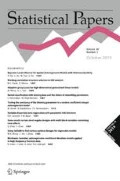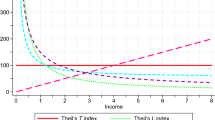Abstract
The evaluation of income distributions is usually based on the Pigou-Dalton (PD) principle which says that a transfer from any people to people who have less decreases economic inequality, i.e., increases the social evaluation index. We introduce two weaker principles of transfers which refer to a parameter θ. With the new principles, only those PD transfers increase the social evaluation index which take from the class of incomes above θ and give to the class below θ. The relative positions of individuals remain unchanged, and either no individual may cross the line θ (principle of transfers about θ) or some may do who have been situated next to it (starshaped principle of transfers at θ). θ may be a given constant, a function of mean income, or a quantile of the income distribution. The classes of indices which are consistent with these transfers are completely characterized, and examples are given.
Similar content being viewed by others
References
Amiel, Y., and F. Cowell (1992). “Measurement of income inequality: Experimental test by questionnai”.Journal of Public Economics 47, 3–26.
Arnold, B.C. (1987).Majorization and the Lorenz Order: A Brief Introduction. Springer Verlag, Berlin.
Atkinson, A. B. (1970). “On the measurement of inequality”.Journal of Economic Theory 2, 244–263.
Barlow, R.E., A.W. Marshall, and F. Proschan (1969). “Some inequalities for starshaped and convex functions”.Pacific Journal of Mathematics 29, 19–42.
Bonferroni, C. (1930).Elementi di Statistica Generale. Libreria Seeber, Firenze.
Bonferroni, C. (1940). “Un indice quadratico di concentrazione”.Atti II Congresso UMI, pp 700–706.
Bresciani-Turroni, C. (1937). “On Pareto’s law”.Journal of the Royal Statistical Society A 3, 421–432.
Castagnoli, E. (1990). “On order preserving functions”. In M. Fedrizzi and J. Kacprzyk, eds.,Proceedings of the 8th Italian Symposium on System Analysis and Decision Support in Economics and Technology, pp 151–165, Omnitech Press, Warszawa.
Castagnoli, E., and P. Muliere (1990). “A note on inequality measures and the Pigou-Dalton principle of transfers”. In C. Dagum and M. Zenga, eds.,Income and Wealth Distribution, Inequality and Poverty, pp 171–182. Springer Verlag, Berlin.
Chakravarty, S.R. (1990).Ethical Social Index Numbers. Springer Verlag, Berlin.
Cowell, F.A. (1977).Measuring Inequality. Philips Allan Publ Ltd., Oxford.
Dalton, H. (1920). “The measurement of the inequality of incomes”.The Economic Journal 30, 348–361.
Davies, J., and M. Hoy (1991). “Making inequality comparisons when Lorenz curves intersect”.Mimeo.
Dasgupta, P., A. Sen, and D. Starrett (1973). “Notes on the measurement of inequality”.Journal of Economic Theory 6,180–187.
Ebert, U. (1984). “A family of absolute measures of inequality”.Methods of Operations Research 48, 129–144.
— (1984). “A family of aggregative compromise inequality measures”.International Economic Review 29, 363–376.
Eichhorn, W. and W. Gehrig (1981). “Generalized convexity and the measurement of inequality”. In S. Schaible and W.T. Ziemba, eds.,Generalized Concavity in Optimization and Economics, pp 637–642. Academic Press, New York.
Eichhorn, W. and W. Gehrig (1982). “Measurement of inequality in economics”. In B. Korte, ed.,Modern Applied Mathematics, Optimization and Operations Research, pp 658–693. North-Holland, Amsterdam.
Eltetö, O. and E. Frigyes (1968). “New income inequality measures as efficient for casual analysis and planning”.Econometrica 36, 383–396.
Fields, G.S. and J.C.H. Fei (1978). “On inequality comparisons”.Econometrica 46, 303–316.
Foster, J.E., and A.F. Shorrocks (1987). “Transfer sensitive inequality measures”.Review of Economic Studies 54, 485–497.
Gehrig, W. (1983). “On a characterization of the Shannon measure”.Utilitas Mathematica 24, 67–85.
— (1984). “Two characterizations of Theil’s concentration measure”.Methods of Operations Research 48, 97–112.
Gini, C. (1912). “Variabilità e mutabilità: contributo allo studio delle distribuzioni e delle relazioni statistiche”.Studi Economico Giuridici dell’Università di Cagliari 3, 1–158.
Hardy, G.H., J.E. Littlewood and G. Polya (1934).Inequalities. Cambridge Univ. Press, London.
Harrison, E., and C. Seidl (1994). “Perceptional inequality and preferential judgements: An empirical examination of distributional axioms”.Public Choice 79, 61–81.
Harsanyi, J.C. (1953). “Cardinal utility in welfare economics and in the theory of risk-taking”.Journal of Political Economy 61, 434–435.
Kolm, S. (1969). “The optimal production of social justice”. In J. Margolis and H. Guitton, eds.,Public Economics, pp 145–200. Macmillan, London.
Kolm, S.Ch. (1976a). “Unequal inequalities I”.Journal of Economic Theory 12, 416–442.
Kohm, S.Ch. (1976b). “Unequal inequalities II”.Journal of Economic Theory 13, 82–111.
Kuznets, S. (1959).Six Lectures on Economic Growth. Free Press of Glencoe, Ilinois.
Landsberger, M. and I. Meilijson (1990). “Lotteries, insurance and star-shaped utility functions”.Journal of Economic Theory 52, 1–17.
Marshall, A. and I. Olkin (1979).Inequalities: Theory of Majorization and Its Applications. Academic Press, New York.
Marshall, A.W., D.W. Walkup, and J.B. Wets (1967). “Order-preserving functions; applications to majorization and order statistics”.Pacific Journal of Mathematics 23, 569–584.
Menezes, C., C. Geiss, and J. Tressler (1980). “Increasing downside risk”.American Economic Review 70, 921–923.
Muliere, P., and G. Parmigiani (1993). “On quasi-means”.Utilitas Mathematica 43, 79–87.
Piesch, W. (1975).Statistische Konzentrationsmaße. J.C.B. Mohr, Tübingen.
Pietra, G. (1915). “Delle relazioni tra gli indici di variabilità, nota I”.Atti del R. Istituto Veneto di Scienze Lettere ed Arti 74, 775–804.
Rothschild, M., and J.E. Stiglitz (1973). “Some further results on the measurement of inequality”.Journal of Economic Theory 6, 188–204.
Schutz, R.R. (1951). “On the measurement of income inequality”.American Economic Review 41, 107–122.
Seidl, C. (1988). “Poverty measurement: A survey”. In D. Bös, M. Rose and C. Seidl, eds.,Welfare and Efficiency in Public Economics, pp 71–147. Springer, Berlin.
Shorrocks, A.F. (1980) “The class of additively decomposable inequality measures”.Econometrica 48, 613–625.
Author information
Authors and Affiliations
Additional information
Research supported by the Vigoni program of the Deutscher Akademischer Austauschdienst and the Conferenza Permanente dei Rettori delle Università Italiane.
Rights and permissions
About this article
Cite this article
Mosler, K., Muliere, P. Inequality indices and the starshaped principle of transfers. Statistical Papers 37, 343–364 (1996). https://doi.org/10.1007/BF02926113
Received:
Revised:
Issue Date:
DOI: https://doi.org/10.1007/BF02926113
Keywords
- Inequality measurement
- relative concentration
- economic disparity
- Pigou-Dalton transfers
- starshaped functions



